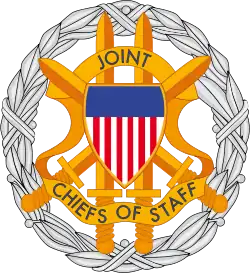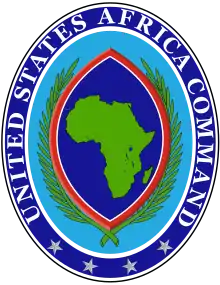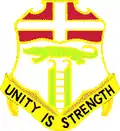Carter Ham
Carter Frederick Ham[2] (born February 16, 1952) is a retired United States Army general who served as the second commander of United States Africa Command.[3] As commander of Africa Command, he led Operation Odyssey Dawn, the initial United States role in the 2011 military intervention in Libya.
Carter Ham | |
|---|---|
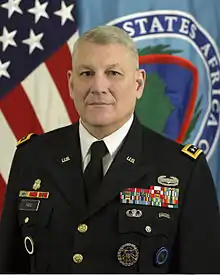 Ham in March 2011 | |
| Born | February 16, 1952 Portland, Oregon, United States[1] |
| Allegiance | United States |
| Service/ | United States Army |
| Years of service | 1973–2013 |
| Rank | General |
| Commands held | United States Africa Command United States Army Europe 1st Infantry Division |
| Battles/wars | Gulf War |
| Awards | Army Distinguished Service Medal (2) Defense Superior Service Medal (4) Legion of Merit (2) Bronze Star Medal |
Ham served as the Commanding General of the United States Army Europe and Seventh Army from August 28, 2008 to March 8, 2011. Prior to that, he served as Director for Operations (J-3) at the Joint Staff from August 2007 to August 2008 and the Commanding General, 1st Infantry Division from August 2006 to August 2007, and was the commander of Operation Able Sentry in Macedonia in the mid-1990s, during the Yugoslav wars.
Early life and education
Ham was born on February 16, 1952 in Portland, Oregon, and attended Charles F. Brush High School in Lyndhurst, Ohio, a suburb of Cleveland. He holds a Bachelor of Arts in Political Science from nearby John Carroll University, as well as a Master of Arts in National Security and Strategic Studies from the Naval War College. He received the rank of Eagle Scout as a youth in 1965 and was bestowed the Distinguished Eagle Scout Award in 2012 from the Boy Scouts of America.
Military career
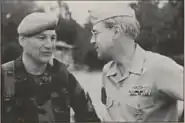
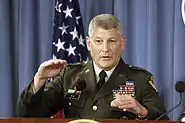
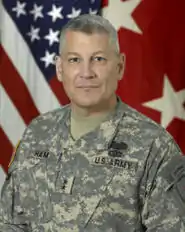
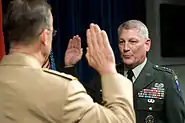
Ham enlisted in the United States Army in 1973 and served as an infantryman in the 82nd Airborne Division before being accepted in the Army Reserve Officers' Training Corps (Army ROTC) while attending John Carroll University in Cleveland, Ohio. An ROTC Distinguished Military Graduate, Ham was commissioned as an infantry officer in 1976. He later received his master's degree in National Security and Strategic Studies from the Naval War College in Newport, Rhode Island as well as graduating from several military schools including the Infantry Officer Basic Course, the Armor Officer Advanced Course, the Naval War College's College of Naval Command and Staff, and the Air War College. He is a member of the John Carroll University ROTC Hall of Fame. He and his wife, Christi, are both John Carroll University graduates.
Ham's early assignments included service at Fort Knox, Kentucky and tours of duty in Italy and Germany. After graduating from the Armor Officer Advanced Course, he was a Recruiting Area Commander in Lima, Ohio. In 1984, he served with a joint service unit in support of the Olympic Games in Los Angeles.
From 1984 until 1989, Ham served as Assistant Inspector General, then as Battalion Operations Officer (S-3) and Executive Officer with the Opposing Force (OPFOR) at the National Training Center, Fort Irwin, California. He attended the College of Naval Command and Staff, graduating with distinction in 1990, and was then assigned to the U.S. Army Infantry School at Fort Benning, Georgia.
Ham served a tour as an advisor with a Saudi Arabian National Guard Brigade in Riyadh as part of OPM-SANG then returned to Fort Benning, where he was the executive officer for the Infantry School. Ham commanded the 1st Battalion, 6th Infantry in Vilseck, Germany including a six-month tour with the United Nations Protection Forces in the Republic of Macedonia. Following battalion command, he was the Senior Observer/Controller of the Timberwolf Team at the Combat Maneuver Training Center, Hohenfels, Germany.
Ham graduated from the Air War College in 1997 then returned to Germany where he served as Operations Officer (G-3), then Chief of Staff, 1st Infantry Division. From 1999 to 2001 he commanded the 29th Infantry Regiment at Fort Benning, then served as Deputy Director for Resources and Analysis (J-8) for United States Central Command at MacDill AFB in Tampa, Florida and in Doha, Qatar, during which time he was selected for promotion to Brigadier General. Ham was assigned as the Deputy Commanding General for Training and Readiness, I Corps at Fort Lewis, Washington in August 2003. In January 2004, he assumed command of Multinational Brigade (Task Force Olympia) – North in Mosul, Iraq serving there until February 2005. During his time in Afghanistan, Ham suffered from post-traumatic stress disorder, which was caused by his attending the aftermath of a deadly suicide bombing at a mess hall. He later sought treatment for his condition and publicly encouraged other soldiers to do the same.[4]
Returning from Iraq, Ham served as the Deputy Director for Regional Operations, J-3, on The Joint Staff. Ham assumed command of the 1st Infantry Division at Fort Riley, Kansas in August 2006 and served as the Commanding General until July 2007, returning to The Joint Staff as Director for Operations, J-3. On August 28, 2008, Ham became the 34th Commander of the United States Army Europe headquartered at Campbell Barracks, Heidelberg, Germany. In 2010, General Ham served as co-chair for the comprehensive review of issues associated with the repeal of the "Don't ask, don't tell" policy.[5]
The United States Senate, confirmed Ham's nomination to become the next Commander of United States Africa Command, headquartered at Kelley Barracks, Stuttgart, Germany, in November 2010.[6] He assumed the post on March 8, 2011.
Ham was in command of United States forces enforcing the Libyan no-fly zone, along with Admiral Samuel J. Locklear. Described as "in charge of the coalition effort", Ham on March 21, 2011 said, "there would be coalition airstrikes on Colonel Qaddafi's mobile air defenses and that some 80 sorties – only half of them by the United States – had been flown on Monday." [7] Admiral Locklear, aboard the flagship Mount Whitney, had tactical command of the Operation Odyssey Dawn joint taskforce.[8] Ham also said he had "full authority to attack the regime's forces if they refused to comply with President Barack Obama's demands that they pull back from Ajdabiya, Misrata and Zawiya," according to one report. Earlier, he said that the United States was not working with the Libyan rebels. "Our mission is not to support any opposition forces," Ham said by video feed to the Pentagon from his headquarters in Stuttgart.[7]
Ham was in overall command of military forces when the September 11, 2012 terrorist attacks were launched on the American consulate and CIA annex in Benghazi, Libya. According to his June 2013 Congressional testimony, Ham chose not to deploy close air support during the attack, based on a lack of situational awareness about the circumstances on the ground. He denied the allegation by some Republicans that President Barack Obama or others in Obama's administration had ordered him to "stand down" a planned rescue mission that was ready to deploy.
After a 24-month tour of duty[9] as Commander Africa Command, Ham was succeeded by General David M. Rodriguez.[10] General Ham retired in June 2013.[5]
Views
Ham was quoted in an online Washington Post article by Greg Miller and Craig Whitlock, posted on October 1, 2012, that, as saying, that, as a result of al-Qaeda in the Islamic Maghreb's overtaking and capturing more territory in Mali in Africa, and possessing arms from Libya after the Libyan Civil War which overthrew Muammar Gaddafi, there is the possibility of the U.S. assisting, but not leading, counterterrorism operations done by other countries. A more radical step would be the use of drones.[11]
While speaking about the Chinese presence that was "everywhere" in Africa, Ham expressed an appreciation for the economic competition between China and the U.S. in Africa, observing that China was "very good at infrastructure development – roads, bridges, airports, government buildings and the like – constructed by the Chinese in – which greatly benefits the African people."[12]
Dates of rank
| Second lieutenant (O-1)* | First lieutenant (O-2)* | Captain (O-3)* | Major (O-4)* | Lieutenant colonel (O-5)* |
|---|---|---|---|---|
| June 2, 1976 | June 2, 1978 | August 1, 1980 | June 1, 1987 | September 1, 1992 |
| Colonel (O-6)* | Brigadier general (O-7)* | Major general (O-8)* | Lieutenant general (O-9*) | General (O-10)* |
|---|---|---|---|---|
| April 1, 1998 | October 1, 2003 | February 1, 2005 | August 1, 2007 | August 1, 2008 |
Note:
* The O-1, etc. designates the pay grade.
Major duty assignments
| Training Officer, II Reserve Officer Training Corps Region, 4th Basic Combat Training Brigade | 1976 |
| Section Leader, Combat Support Company, 1st Battalion, 509th Infantry (Airborne Combat Team) | 1977–1978 |
| S-1 (Personnel), 2d Battalion, 22d Infantry, 4th Infantry Division | 1978–1979 |
| Commander, C Company, 2d Battalion, 22d Infantry, 8th Infantry Division | 1979–1981 |
| Student, Armor Officer Advanced Course | 1981–1982 |
| Lima Area Commander, Columbus District Recruiting Command | 1982–1984 |
| Detachment Commander, Forward Military Support Element, 1984 Summer Olympics | 1984 |
| Assistant Inspector General, National Training Center | 1984–1986 |
| S-3 (Air), 6th Battalion (Mechanized), 31st Infantry | 1986–1987 |
| Executive Officer, 1st Battalion (Mechanized), 52d Infantry | 1987–1989 |
| Student, College of Naval Command and Staff, U.S. Naval War College | 1989–1990 |
| Executive Officer, United States Army Infantry School | 1990–1993 |
| Commander, 1st Battalion, 6th Infantry, 3d Infantry Division | 1993–1995 |
| Senior Task Force Observer/Controller, Operations Group, Combat Maneuver Training Center | 1995–1996 |
| Student, United States Air Force Air War College | 1996–1997 |
| Chief of Staff, 1st Infantry Division | 1997–1999 |
| Commander, Infantry Training Support Brigade, 29th Infantry Regiment | 1999–2001 |
| Deputy Director, J-8, United States Central Command | 2001–2003 |
| Deputy Commanding General for Training and Readiness, U.S. I Corps | 2003–2004 |
| Commander, MNB North (Task Force Olympia) (Mosul, Iraq) | 2004–2005 |
| Deputy Director for Regional Operations, J-3, The Joint Staff | 2005–2006 |
| Commander, 1st Infantry Division | 2006–2007 |
| Director for Operations (J-3), The Joint Staff | 2007–2008 |
| Commanding General, United States Army Europe and Seventh Army | 2008–2011 |
| Commander, United States Africa Command | 2011–2013 |
Decorations and badges
| Army Distinguished Service Medal (with one bronze oak leaf cluster) | |
| Defense Superior Service Medal (with three oak leaf clusters) | |
| Legion of Merit (with oak leaf cluster) | |
| Bronze Star Medal | |
| Meritorious Service Medal (with silver oak leaf cluster) | |
| Joint Service Commendation Medal | |
| Army Commendation Medal (with two oak leaf clusters) | |
| Army Achievement Medal (with two oak leaf clusters) | |
| Joint Meritorious Unit Award (with two oak leaf clusters) | |
| Meritorious Unit Commendation | |
| Superior Unit Award (with oak leaf cluster) | |
| National Defense Service Medal (with two bronze service stars) | |
| Southwest Asia Service Medal (with service star) | |
| Iraq Campaign Medal (with two service stars) | |
| Global War on Terrorism Service Medal | |
| Armed Forces Service Medal | |
| Army Service Ribbon | |
| Overseas Service Ribbon (with bronze award numeral 3) | |
| United Nations Medal | |
| NATO Medal for the former Yugoslavia | |
| Polish Army Medal in Gold[13] | |
| Kuwait Liberation Medal (Saudi Arabia) | |
| Kuwait Liberation Medal (Kuwait) |
References
- "S.Hrg 111-896 Nominations before the Senate Armed Services Committee, Second Session, 111th Congress" (PDF). November 18, 2010.
- "Commencement". John Carroll University. May 30, 1976. Retrieved November 22, 2020.
- Seasoned combat leader takes over Africa Command Archived February 19, 2015, at the Wayback Machine
- Brook, Tom Vanden (November 25, 2008). "General's story puts focus on stress stemming from combat". USA Today. Gannett Co., Inc. Archived from the original on February 7, 2014. Retrieved February 7, 2014.
- "General (Retired) Carter F. Ham". Response Systems to Adult Sexual Assault Crimes Panel (RSP), United States Department of Defense. November 7, 2013. Archived from the original on March 12, 2014. Retrieved March 12, 2014.
- "General Carter F. Ham: Commanding General, U.S. Army Europe (biography)" (PDF). U.S. Army Europe. February 2011. Archived from the original (PDF) on January 6, 2012.
- Bumiller, Elisabeth, and Kareem Fahim, "U.S.-Led Assault Nears Goal in Libya", The New York Times, March 21, 2011 (March 22, 2011 p. A1 NY ed.). Earlier web version titled: "Qaddafi Forces Hold Strategic Town as Allied Attacks Continue." Retrieved 2011-03-21.
- MacAskill, Ewen, and Nick Hopkins, “Libyan operation hampered by confusion and dispute: Lack of resolution over who will take control of military operation tests patience of US”, The Guardian 21 March 2011 18.59 GMT. Retrieved 2011-03-21.
- Scarborough, Rowan (November 7, 2012). "Head of Africa Command not forced out". The Washington Times. Archived from the original on November 8, 2012.
- "General Carter F. Ham, Former Commander (March 2011 – April 2013)". U.S. Africa Command. July 24, 2013. Archived from the original on September 1, 2013. Retrieved March 12, 2014.
- Miller, Greg; Whitlock, Craig (October 1, 2012). "White House secret meetings examine al-Qaeda threat in North Africa". The Washington Post. The Washington Post Company.
- "General Ham at the Chatham House, London". Africom. Archived from the original on January 24, 2013.
- Generał Carter F. Ham w Polsce Archived June 3, 2011, at the Wayback Machine (photo) Archived September 27, 2011, at the Wayback Machine – wp.mil.pl
External links
| Wikimedia Commons has media related to Carter Ham. |
- "General Carter F. Ham, Commander, United States Africa Command". Archived from the original on August 29, 2013. Retrieved August 5, 2012.CS1 maint: bot: original URL status unknown (link)
- Appearances on C-SPAN
